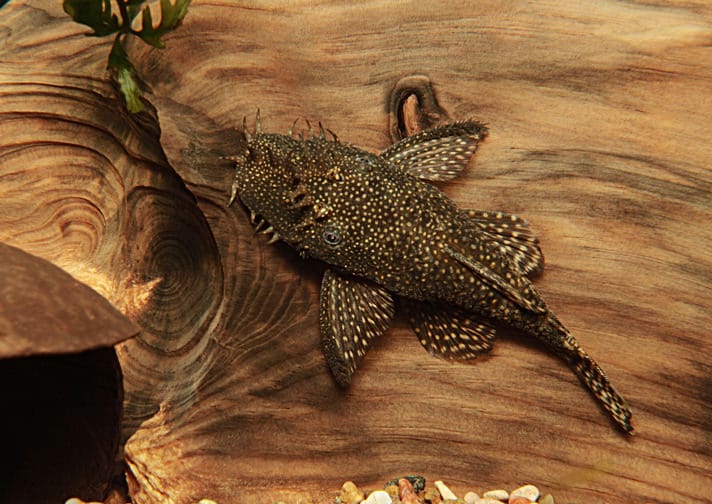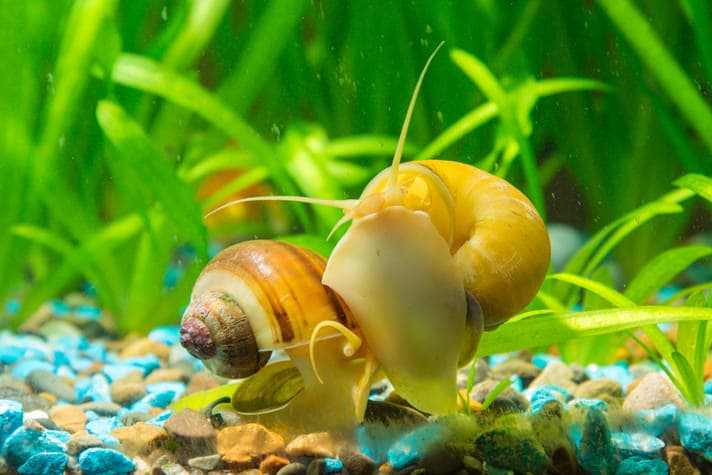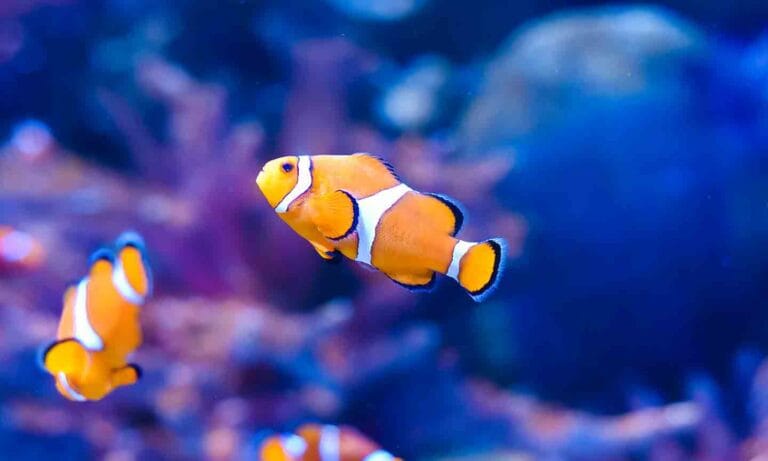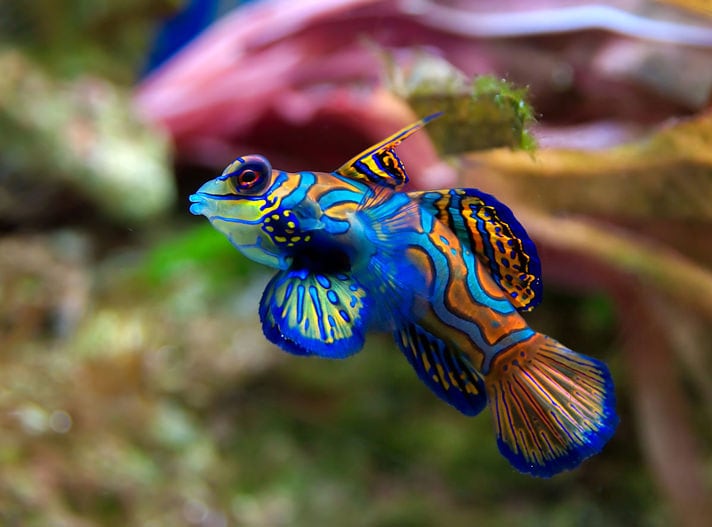Algae growth is an intruder for many aquarists. It can be slimy, hairlike and can turn water green like pea soup. Whatever form it takes, algae can undermine the pleasure of the aquarium hobby.
Only a few hobbyists have not needed to battle algae at least once in the course of their aquarium keeping. So, we hobbyists are always on the lookout for a safe, natural way to control algae, which leads us to various fish and invertebrates that eat algae. There is no safer or more satisfying way to be rid of algae than to use it to fatten up an interesting critter. I’m going to introduce you to some of the best algae-eaters and also warn you away from those that are a waste of time.
Picking the Proper Algae-eater
Let’s talk about the various interesting creatures that help us keep algae growth under control. While it seems a shame that we might need to buy a fish or snail just because it eats algae, the upside is that most algae-eating creatures are attractive or interesting in their own right. And there are those, such as plecos, that are so ugly that it makes them interesting. They would be fun to keep, even if they didn’t eat algae.
Plecos
Various South American suckermouth catfish are effective algae-eaters. The most popular are the various species sold as “plecos.” The namesake for the group, the common pleco (Hypostomus plecostomus), is an excellent algae-eater but is not the best choice for most hobbyists. Dealers sell small, inexpensive youngsters without warning that they can grow to 2-foot adults. However, if you want an algae-eater to keep with large fish, the common pleco is a good, hardy choice.
For typical community aquariums, the various species of bushynose pleco (Ancistrus spp.) and clown pleco (Peckoltia spp.) are better choices. Bushynose plecos develop beard-like tentacles on the face. Clown plecos have strong striped patterns. You may also run into the aptly described widemouth plecos (Chaestostoma spp.).
All of these species stay small (4 to 6 inches) and eat algae well. Many will spawn readily in a fish aquarium, too. They build caves under rocks and even protect their eggs and fry. Plecos can readily handle gold or green slime. Their tough, rough lips will reduce green dot algae to a certain extent, as well. Plecos may have a face only a mother pleco could love, but they make the best window cleaners.
Twig catfish
Farlowella are shaped like twigs and spend much time hanging in plants or attached to driftwood branches. They are well-camouflaged. Stick catfish and farlowella are other common names. Twig cats grow to 7 inches, and their algae-eating ability is on par with plecos.
Whiptail catfish
Two species of whiptail are common in the trade: Rineloricaria hasemani and R. parva. These fish look like stretched-out, flattened plecos, and their algae eating capability is also similar to the pleco. You may see them sold as lizard catfish.
Otocinclus
Pygmy suckermouths (Otocinclus spp.) are fantastic algae-eating choices. Their body shape resembles an elongated pleco, but they lack the armor. They are also considerably smaller, growing only to 2 inches. This gives otos the ability to clean algae off small plant leaves and fit into smaller spaces to perform their cleaning tasks.
Unlike plecos, which are loners, pygmy sucker cats are schooling fish and should be kept in groups of three or more. Otocinclus vittatus and Macrotocinclus affinis are the most common species sold in North America. They will keep all soft film algae off glass, plant leaves and decorations. I do offer a warning with Otocinclus, though. They are all wild-caught and sometimes arrive loaded with internal worms. The stresses of capture and shipping, and infrequent feedings during this process can give the worms an upper hand, so to speak. Sadly, the otos that arrive in stores are often sickly. Make sure your dealer has had the fish in stock for at least a week to be sure they are in good shape before buying them.
Siamese algae-eater
The Siamese algae-eater is highly sought-after by hobbyists because of its ability to eat brush or beard algae, but there has been a lot of confusion about which fish is the Siamese algae-eater. Some books and websites have pictures of entirely wrong species, adding to the confusion is that this fish was once called the Siamese flying fox, a name shared by other fish. The fish you want for cleaning algae is Crossocheilus siamensis.
To distinguish this fish from similar but less productive algae-eaters, look for the stripe. A solid black stripe runs from the tip of the nose through the eye and straight through the center of the tail. If the stripe stops at the base of the tail, you have the wrong fish. Then look above the stripe. There should be no other stripe. If there’s a pale golden stripe, you probably have the flying fox (Epalzeorhynchos kalopterus), which is a bit of an algae-eater, too, but it won’t touch brush algae. The Siamese algae-eater has clear fins. The flying fox has black bands in the dorsal, anal and ventral fins. Siamese algae-eaters prefer to live in schools, so buy a group of three or more. Be aware, however, that they do grow to around 6 inches.
Flying fox
This fish resembles a Siamese algae-eater but with more color. It’s actually attractive enough to be kept for its looks alone. The flying fox (Epalzeorhynchos kalopterus) eats a bit of algae and is related to red-tailed and rainbow sharks. Like the sharks, it’s quite territorial toward its own and similar-looking species, so keep no more than one per community. Adult size is up to 6 inches. This fish and its shark relatives will all graze on soft slime algae.
Stone-lapping fish
Another species sometimes confused with the Siamese algae-eater and the flying fox is the stone-lapping fish (Garra cambodgiensis). It looks a bit like a faded flying fox, with a heavier body and less color in the fins. The stripe does not run through the tail. This fish will graze on soft slime algae.
Florida flagfish
A native fish that sometimes shows up in stores is the Florida flagfish (Jordanella floridae). It nibbles on brush or beard algae, an algae type that most algae-eaters won’t touch. The downside is that it can be someone nippy toward tankmates. It grows to 2.5 inches.
Other fish
Of course, many fish we don’t classify as algae-eaters will eat a bit of algae. They’re just not as efficient at it. For example, mollies love to pick at algae. Kissing gouramis will rasp what they can from surfaces, and most barbs will nibble here and there.
Algae-Eating Inverts
When it comes to algae-eating, don’t forget the invertebrates! Snails and shrimp are just two types of inverts that can help in the battle against algae.
Snails
Not all algae-eaters are fish. In the early days of the hobby, snails were about the only algae control we had, and it was common to find an aquarium or bowl that contained some kind of snail as a scavenger. They are not as good at clearing algae as some of the fish already noted, but they still have value and add to the interest of an aquarium. Snails create zipper-like tracks through the algae as they eat, using a rasping tongue. They do best in water that is hard and a little alkaline in pH. The dissolved calcium in hard water helps them build their shells and maintain them in good health.
Ramshorn snails (Planorbis corneus and others) stay small and are good little scavengers. The shell curves like a ram’s horn. A red variety is very popular when you can find it. Pond snails (Physa acuta and others) stay similarly small. Both of these varieties are fast breeders, laying masses of jellylike eggs on glass and plants. They are hermaphrodites, which means they fertilize each other-two snails lay two batches of eggs. Another small snail is the Malaysian needlepoint or trumpet snail (Melanoides tuberculata). You only need one to breed. Males are rare, and females deliver clone babies of themselves. This snail hides in the gravel during the day, so you may not realize you have a jillion of them until you turn on the lights at night.
If you would like something bigger, look for mystery snails (Pomacea bridgesii). The mystery is where they got their common name! These snails are the size of ping-pong balls and are interesting to watch with their long antennae. Their cousins, the even larger apple snails, are now rarely available in the hobby to prevent hobbyists from releasing them into the wild. Apple snails (but not the mystery snail) gorge themselves on aquatic plants and can destroy aquatic habitats. The Colombian ramshorn snail is another relative that eats plants.
If you have any of these snails, don’t worry. The law applies to the transportation of snails, not ownership. Live snails can no longer be imported, and suppliers must obtain a USDA permit to ship snails across state lines. Permits will not be issued for apple snails (Pomacea spp.) except for the mystery snail, P. bridgesii.
Shrimp
Several small shrimp have become popular for algae control. These crustaceans do little to deal with the filmy types of algae, but they effectively nibble on the various brush and thread algae. The difficulty is that the shrimp are small and fish like shrimp dinner, so it’s not always safe to mix shrimp into a community. Be very careful to combine them only with smaller fish, and it’s best if you plant the tank heavily.
The most desired shrimp is the Amano shrimp (Caridina multidentata), named for the Japanese hobbyist Takashi Amano, who introduced them to the U.S. It’s slightly greenish with brick-colored dots. The cherry shrimp (Neocaridina denticulata) is red, and the crystal shrimp (Caridina spp.) is bright red and white. These shrimp grow to around an inch. An easier and cheaper shrimp to obtain is the ghost shrimp (Palaemonetes paludosus) from the southern U.S. It is very inexpensive, grows to 2 inches and usually sells as food for large fish. Finally, the wood shrimp (Atyopsis moluccensis), which is also called the rock, parasol, fan or bamboo shrimp, is unusual in that it will eat blue-green algae. It’s the only animal discussed here that is known to do so. This odd shrimp is a filter-feeder. Its front appendages have evolved from claws into umbrellalike fans. It spreads these in the water current to filter out microorganisms for food. It also uses them as claspers to pick up food from the substrate.
Freshwater Clams
Clams are filter-feeding mollusks that sometimes show up for sale in stores. They are the only critters that may be useful for green water control. They can filter out and eat the single-celled algae that cause green water. Even better, a clam can filter a lot of water fast. But be aware that because clams are filter feeders, they starve in the typical aquarium – the water is just too clean. Hobbyists should not buy clams unless they want to try them to solve a green water problem. In particular, do not buy clams for their looks because the first thing they do is bury themselves in the gravel. You will likely never see your clam again, even after the green water clears.
I hoped I’ve steered you toward the right choices for controlling whatever type of algae is in your aquarium. Hopefully, algae will no longer be a problem for you. Happy fishkeeping!
These Don’t Eat Algae
Chinese algae-eater. Do you know which algae-eater sells in the largest numbers in the U.S.? It’s the Chinese algae-eater (Gyrinocheilus aymonieri) – it is also the worst choice. Dealers sell this fish by the tankload because it’s cheap. Hobbyists buy it in large numbers because it has “algae-eater” in its name. The Chinese algae-eater is not from China; it’s from Thailand. Nor is it a good algae-eater, though it will eat some slime algae when young.
If not eating algae was the worst of it, it would be no big deal, but it gets worse. Chinese algae-eaters become quite aggressive when they grow. They tend to feed off the body slime of other fish in the tank, killing them. It is common for the Chinese algae-eater to be the sole survivor in an aquarium. The hobbyist is left wondering why every new fish introduced goes to the great fish bucket in the sky, never suspecting an algae-eater of being a piscivore. Recognize this bad boy by the checkerboard pattern on its side.
Zebra pleco
The beautiful and expensive zebra pleco (Hypancistrus zebra) is, oddly, not an algae-eater. It wants more meaty foods in its diet. Nerite snails. Lately, some attractive nerite snails have shown up in shops. They survive for a time in freshwater and eat algae, but they require saltwater to breed. So nerites are not the best choice for a freshwater aquarium. Fish are only one type of animal that eats algae. There are many algae-eating snails, shrimp and clams that can be interesting additions to your tank. Florida flagfish (Jordanella floridae) are great additions to the aquarium that has a brush or beard algae problem. Most other algae-eaters won’t eat this type of algae.
Types of Algae
Before I describe algae-eating species, let’s talk briefly about the types of algae you may encounter. It’s important to know this because no species of algae-eater eats every kind of algae. You need to know the algae type to properly match an algae-eating animal to the algae, or you will end up with a tank of both algae and starving algae-eaters.
Gold slime
This is the first type of algae growth a hobbyist is likely to encounter. A thin brown or golden slime develops on glass and decorations. It may begin looking like a few rust-colored spots. Gold slime is most common in new aquariums or tanks with low light levels. This algae is very soft and wipes away with a finger. It is caused by diatoms, single-celled organisms that build a silica shell.
Green slime
This is a soft green film. Hobbyists don’t actually see green slime algae much because it’s so easily cleaned away by algae-eating fish.
Brush algae
Also called beard algae, this forms as short, hairy tufts. It usually appears on the leaf edges of tough-leaved plants, such as Anubias. It also forms on decorations and rocks. You can pull bits of brush algae off with your fingers, but you cannot wipe it away or remove it all. It usually appears to be dark green, but seen under the microscope, it’s a surprise to find it’s actually a type of red algae. There are types of brush algae that are visibly red, but they are less common.
Hair algae and thread algae
These develop as long threads. They may form thick masses or individual threads, either floating or attached.
Blue-green algae
This algae forms thick, greasy sheets that envelop plants, gravel and eventually everything. Usually, the algal sheets are deep blue-green in color, as the name implies, but sometimes they look more mustard colored. If you stick your hand in the water and flick your finger at this algae, small sheets of it will easily roll away because it does not attach firmly. This highly dreaded algae is caused by cyanobacteria. It’s not just unattractive but toxic to most species. It is inedible by most algae-eaters.
Green dot algae
As the name implies, this takes the form of small green dots on glass, decorations, and plants. You mostly see this in older aquaria. The dots themselves are small and relatively unobtrusive, but copious colonies on the glass obstruct the view. This algae is tough to remove. A razor blade works best – algae-eaters have little effect on it.
Green water
This is not common, but it is a serious headache. Single-celled microscopic organisms turn the water pea green. In severe cases, you can hardly see the fish. Algae-eating fish are of no help with this one.
Posted by: Chewy Editorial
Featured Image Via Igors Reisonoks/Thinkstock
Share:









